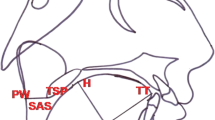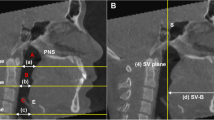Abstract
Introduction
The changes in length and height of tongue following mandibular setback (MS) surgery may affect pharyngeal airway dimensions. There is limited literature correlating tongue dimensional changes with linear and volumetric airway changes following MS with bilateral sagittal split ramus osteotomy (BSSRO) in skeletal class III patients.
Materials and Methods
Treatment records of 18 patients who underwent MS with BSSRO were evaluated for changes in tongue and linear airway dimensions, mean airway volume and area at T1 (1-week pre-surgery), T2 (6-month post-surgery) and T3 (2-year post-surgery). Amount of MS was recorded from case sheets of patients. Mean tongue length reduced, whereas mean tongue height increased at T2 compared to T1 (P value = 0.001 for both). Linear, area and volumetric airway parameters at T2 were significantly reduced (P value = 0.001). All parameters showed statistically nonsignificant increase from T2 to T3 (P value > 0.05). Correlation analysis showed that change in tongue length at T3 did not show statistically significant correlation with amount of MS, changes in linear, area and volumetric airway parameters (P value > 0.05). However, the change in tongue height at T3 showed a significant (P value < 0.05) negative correlation (r value = − 0.742) with change in posterior airway space (PAS).
Conclusions
The appraisal of tongue length and height after MS surgery should be an integral part of diagnosis and treatment planning. The retro-positioning of tongue and increase in its height after MS surgery may compromise pharyngeal airway especially PAS. Additional options such as bi-jaw surgery, debulking of tongue volume and genioplasty should be explored to minimize adverse effects post-surgically.



Similar content being viewed by others
References
Ishii I, Morita S, Takeuchi Y, Nakamura S (1987) Treatment effect of combined maxillary protraction and chincap appliance in severe skeletal class III cases. Am J Orthod Dentofac Orthop 92(4):304–312
Mendiratta A, Mesquita AAM, Kamat NV, Dhupar V (2014) Orthosurgical management of a severe class III malocclusion. J Ind Orthod Soc 48(4):273–279
Altug-Atac AT, Bolatoglu H, Memikoglu UT (2008) Facial soft tissue profile following bimaxillary orthognathic surgery. Angle Orthod 78(1):50–57
Santagata M, Tozzi M, Lamart E, Tartaro G (2015) Effect of orthognathic surgery on the posterior airway space in patients affected by skeletal class III malocclusion. J Maxillofac Oral Surg 14(3):682–688
Enacar A, Aksoy AU, Sencift Y, Haydar B, Aras K (1994) Changes in hypopharyngeal airway space and in tongue and hyoid bone positions following the surgical correction of mandibular prognathism. Int J Adult Orthod Orthognath Surg 9:285–290
Guven O, Saracoglu U (2005) Changes in pharyngeal airway space and hyoid bone positions after body ostectomies and sagittal split ramus osteotomies. J Craniofac Surg 16:23–30
Degerliyurt K, Ueki K, Hashiba Y, Marukawa K, Nakagawa K, Yamamoto E (2008) A comparative CT evaluation of pharyngeal airway changes in class III patients receiving bimaxillary surgery or mandibular setback surgery. Oral Surg Oral Med Oral Pathol Oral Radiol Endod 105:495–502
Tselnik M, Pogrel MA (2000) Assessment of the pharyngeal airway space after mandibular setback surgery. J Oral Maxillofac Surg 58:282–285
Hochban W, Schurmann R, Brandenburg U, Conradt R (1996) Mandibular setback for surgical correction of mandibular hyperplasia: does it provoke sleep-related breathing disorders. Int J Oral Maxillofac Surg 25:333–338
Lowth A, Juge L, Knapman F et al (2018) Dynamic MRI tongue deformation patterns during mandibular advancement and associations with craniofacial anatomy in OSA. J Sleep Res. https://doi.org/10.1111/jsr.169_12766
Achilleos S, Krogstad O, Lyberg T (2000) Surgical mandibular advancement and changes in uvuloglossopharyngeal morphology and head posture: a short- and long-term cephalometric study in males. Eur J Orthod 22:367–381
Turnbull NR, Battagel JM (2000) The effects of orthognathic surgery on pharyngeal airway dimensions and quality of sleep. J Orthod 27:235–247
Chen F, Terada K, Hua Y, Saito I (2007) Effects of bimaxillary surgery and mandibular setback surgery on pharyngeal airway measurements in patients with class III skeletal deformities. Am J Orthod Dentofac Orthop 131:372–377
Mallampati SR et al (1985) A clinical sign to predict difficult tracheal intubation: a prospective study. Can Anaesth Soc J 32(4):429–434
Samman N, Tang SS, Xia J (2002) Cephalometric study of the upper airway in surgically corrected class III skeletal deformity. Int J Adult Orthod Orthognath Surg 17:180–190
Guven O, Saracoolu U (2005) Changes in pharyngeal airway space and hyoid bone positions after body ostectomies and sagittal split ramus osteotomies. J Craniofac Surg 16:23–30
Irani SK, Oliver DR, Movahed R, Kim YI, Thiesen G, Kim KB (2018) Pharyngeal airway evaluation after isolated mandibular setback surgery using cone-beam computed tomography. Am J Orthod Dentofac Orthop 153(1):46–53
Agarwal SS, Jayan B, Kumar S (2015) Therapeutic efficacy of a hybrid mandibular advancement device in the management of obstructive sleep apnea assessed with acoustic reflection technique. Indian J Dent Res 26:86–89
Tsolakis IA, Venkat D, Hans MG, Alonso A, Palomo JM (2016) When static meets dynamic: comparing cone-beam computed tomography and acoustic reflection for upper airway analysis. Am J Orthod Dentofac Orthop 150(4):643–650
Malkoc S, Usumez S, Nur M, Donaghy CE (2005) Reproducibility of airway dimensions and tongue and hyoid positions on lateral cephalograms. Am J Orthod Dentofac Orthop 128:513–516
Miles PG, O’Reilly M, Close J (1995) The reliability of upper airway landmark identification. Aust Orthod J 14:3–6
Gu G, Gu G, Nagata J, Suto M, Anraku Y, Nakamura K et al (2000) Hyoid position, pharyngeal airway and head posture in relation to relapse after the mandibular setback in skeletal class III. Clin Orthod Res 3:67–77
Swanson LT, Murray JE (1969) Partial glossectomy to stabilize occlusion following surgical correction of prognathism. Report of a case. Oral Surg Oral Med Oral Pathol Oral Radiol Endod 27:707–715
Karamese M, Akdag O, Selimoglu MN, Abacı M, Akatekin A, Tosun Z (2014) Combined therapy for mandibular prognathism: sagittal split osteotomy with excision of tongue. Mod Plast Surg 4:53–57
Kitagawara K, Kobayashi T, Goto H, Yokobayashi T, Kitamura N, Saito C (2008) Effects of mandibular setback surgery on oropharyngeal airway and arterial oxygen saturation. Int J Oral Maxillofac Surg 37:328–333
Tan SK, Leung WK, Tang ATH, Zwahlen RA (2017) Effects of mandibular setback with or without maxillary advancement osteotomies on pharyngeal airways: an overview of systematic reviews. PLoS ONE. https://doi.org/10.1371/journal.pone.0185951
Fernandez Ferrer L, Montiel Company JM, Pinho T, Almerich Silla JM, Bellot AC (2015) Effects of mandibular setback surgery on upper airway dimensions and their influence on obstructive sleep apnoea—a systematic review. J Cranio Maxillofac Surg 43(2):248–253
Canellas JV, Barros HL, Medeiros PJ, Ritto FG (2016) Sleep-disordered breathing following mandibular setback: a systematic review of the literature. Sleep Breath 20(1):387–394
Author information
Authors and Affiliations
Corresponding author
Ethics declarations
Conflict of Interest
The authors declare that they have no competing interests.
Ethical Approval
The study design was approved by the Institutional Ethical Committee.
Additional information
Publisher's Note
Springer Nature remains neutral with regard to jurisdictional claims in published maps and institutional affiliations.
Rights and permissions
About this article
Cite this article
Sahoo, N.K., Agarwal, S.S., Datana, S. et al. Effect of Mandibular Setback Surgery on Tongue Length and Height and Its Correlation with Upper Airway Dimensions. J. Maxillofac. Oral Surg. 20, 628–634 (2021). https://doi.org/10.1007/s12663-020-01372-5
Received:
Accepted:
Published:
Issue Date:
DOI: https://doi.org/10.1007/s12663-020-01372-5




